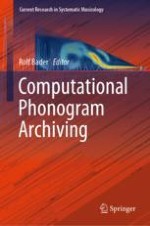2019 | OriginalPaper | Chapter
How to Interprete Early Recordings? Artefacts and Resonances in Recording and Reproduction of Singing Voices
Authors : Malte Kob, Tobias A. Weege
Published in: Computational Phonogram Archiving
Publisher: Springer International Publishing
Activate our intelligent search to find suitable subject content or patents.
Select sections of text to find matching patents with Artificial Intelligence. powered by
Select sections of text to find additional relevant content using AI-assisted search. powered by
